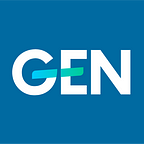Grafiti
Grafiti aims to become the Instagram for Data, making it easy for anyone to explore, create, and share stories from data in minutes from anywhere. Grafiti won the ‘Make it visual!’ battle of our Startups for News competition. They pitch in front of 750+ industry leaders at the GEN Summit 2018. We asked the team a few questions about their startup.
What did you do prior to launching Grafiti?
Our team bonded over the shared frustration with the state of discourse on social media. As fellow data nerds, we believe that there’s plenty of data available to help fight mis– and disinformation. To beat it, particularly at the speed it spreads, we also believe that data-backed expression and storytelling is a skill that everyone, not just journalists, should have.
Farhan Mustafa, CEO, is a former investigative data journalist at Al Jazeera and antitrust economist. Akbar Dawood, CFO, is a former investment banker at Crédit Suisse and startup adviser for the University of Maryland. Iain Bryson, our CTO, built and ran analytics products teams at Microsoft for over 14 years and holds a Masters degree in robotics. Juan, our Chief of Design, founded and ran an agency focused on art + UX called Uneven Media.
What problem are you trying to address for newsrooms?
According to a recent Google News Lab survey (September 2017), media organisations take an average of three days to create a single data-driven story. It’s an often painstakingly lengthy and expensive process to turn data into a web interactive, even for top publishers. While larger newsrooms can afford data journalism teams, the tens of thousands of smaller ones cannot.
At a time when mis– and disinformation and data can spread in minutes, data journalism still lacks the ease, immediacy, cost-efficiency, and social media reach of nearly all other forms of content right now. These challenges are compounded by a huge skills gap in data literacy across all newsrooms, despite the wide availability of local, open data.
Newsrooms across the world face decreasing public trust and tighter budgets, with an increasing need for better, faster data journalism. In order to meet the demand, newsrooms need data journalism tools that more journalists can use with confidence.
How are you attempting to solve the problems described above?
Grafiti empowers newsrooms with any data skill levels to explore vetted, trusted datasets; create interactive data content; and publish to multiple formats and channels — including video and interactives — in a single click. Within minutes, a journalist can publish an animated data story optimised for social and mobile audiences.
In our current trials, Grafiti’s mobile and web tools help publishers create visual, data-backed content up to 50 times faster and cheaper than existing solutions. Grafiti is also partnering with the world’s leading data institutions like UNICEF and the World Bank, both public and private, to provide as much clean, aggregated data as possible. This way newsrooms can focus on telling stories — not wrangling data.
Newsrooms can also publish their original insights and datasets to Grafiti’s Feed, where other journalists and audiences can access their insights to remix and add content (with original attribution). Grafiti also takes data journalism one-step further to create user-generated content. Our deep-linked content allows audiences to take base visualisations and add their own context and share insights across social media.
What sets you apart from your competitors? List three elements.
- Grafiti is easier and faster to use. Our UX was purposely designed mobile-first for data novices to find the most intuitive paths to data expression. Our growing feed of insights from publishers also provides immediate content and jump-starts new stories for other newsrooms. We can power data journalism up to 50 times faster than current solutions.
- Grafiti generates content beyond web interactives. We help create content optimised for social and mobile experiences — like video — and even power user-generated content. We are also helping publishers turn static archives into animated content. Grafiti extends the life of data journalism content at a time when audiences are hungry to share facts.
- Grafiti contextualises data for exploration. We deliver clean, actionable data that’s contextualised with both natural language queries and embedded content for easier searchability and exploration. We let storytellers focus on visual stories, not spreadsheets.
What is your business model?
We will generate revenue by selling SaaS subscriptions of our tool and data access to newsrooms and other types of content creators and data teams. Currently, we’re focusing on customers in the media, NGO, and content marketing spaces. We offer free public tools and our iOS app is live in the App Store.
What are your next steps?
We’re currently focused on testing our product and completing our pilots with the Associated Press, UNICEF, Thomson Reuters, and NewsPicks. We’re also gearing up for our beta web launch and a major iOS update in April 2018. We aim to be fully in-market by summer 2018.
On the product side, we’re refining our embeddable, interactive visualisations as well as GIF and video story creation.
We also continue to integrate with open and private data partners and build the Grafiti community of data storytellers, data providers, insightful audiences, and armchair statisticians.
